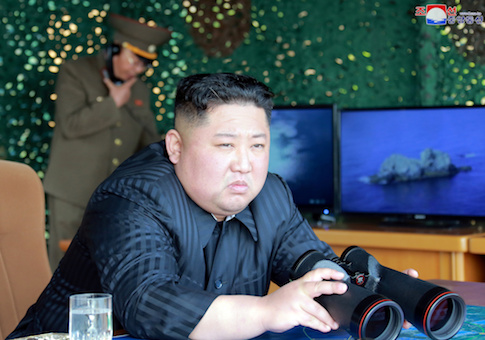After decades of satellite surveillance by foreign governments and analysts, North Korea has sent its first spy satellite on a global orbit with a message to the world: We can watch you, too.
On Tuesday North Korean state media said leader Kim Jong Un had reviewed spy satellite photos of the White House, Pentagon, and U.S. aircraft carriers at the naval base of Norfolk.
North Korea last week successfully launched its first reconnaissance satellite, which it has said was designed to monitor U.S. and South Korean military movements.
Since then state media has reported the satellite photographed cities and military bases in South Korea, Guam, and Italy, in addition to Washington.
"Remember when you got that toy you always wanted at Xmas and were so excited you wanted to tell everyone about it?" Chad O'Carroll, founder of the North Korea-focused website NK News, said of the KCNA reports in a post on X.
So far, Pyongyang has not released any imagery, leaving analysts and foreign governments to debate how capable the new satellite actually is.
South Korea, which said on Tuesday the Nov. 30 launch date for its own first spy satellite on a U.S. Falcon 9 rocket would be delayed by weather, has said the North's satellite capabilities could not be verified.
In Washington, the Pentagon said North Korea's satellite did enter orbit but did not comment on Pyongyang's claims about the images it had captured.
"I will say that there are plenty of images of the Pentagon and the White House online," Pentagon spokesperson Brigadier General Patrick Ryder told reporters.
There's no reason to doubt that the satellite could see the large areas or warships North Korea claimed it could, as even a medium-resolution camera could offer Pyongyang that capability, said Dave Schmerler, a satellite imagery expert at the James Martin Center for Nonproliferation Studies (CNS).
"But how useful those images are depends on what they want to use them for," he said.
For medium-resolution satellites to be useful in a conflict, North Korea will need to launch many more to allow more frequent passes over key sites, Schmerler said, a goal that the North's space agency has said it is pursuing.
"It's a big leap for them going from zero to something, but until we can see the images they're collecting, we're speculating on its use cases," he said.
Jeffrey Lewis, another researcher at CNS, said a state media photo of Kim examining the satellite images with his daughter suggest they may be panchromatic, a type of black-and-white photography that is sensitive to all wavelengths of visible light.
North Korea released panchromatic imagery of downtown Seoul after a rocket launch in December 2022 in what it said was a test of the satellite control, image taking, and data downlink for its eventual military reconnaissance satellite.
Tuesday's photos were the latest in a series of images of what KCNA described as "major target regions".
Kim also inspected satellite photos of the Andersen Air Force Base in the U.S. Western Pacific territory of Guam and a U.S. shipyard and airbase in Norfolk and Newport, where four nuclear-powered aircraft carriers and a British aircraft carrier were spotted, KCNA said.
Commercial imagery of those cities on Nov. 27, the day North Korea says it captured its photographs, was not immediately available.
The United States and South Korea have condemned the satellite launch as a violation of U.N. Security Council resolutions banning any use of ballistic technology.
(Reporting by Hyonhee ShinEditing by Chris Reese, Gerry Doyle, and Sandra Maler)
